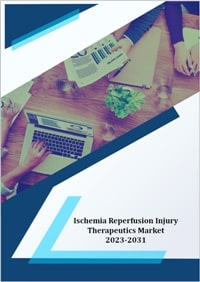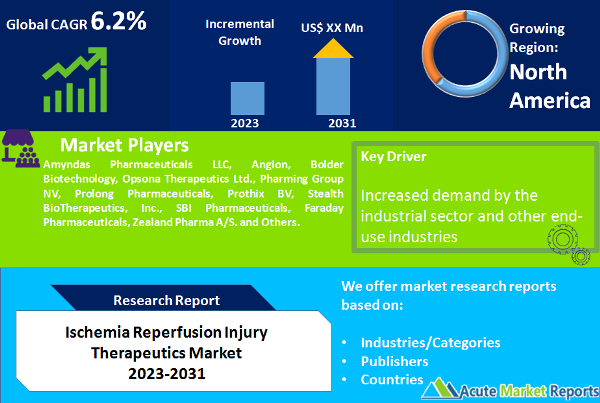
The market for ischemia-reperfusion injury therapeutics is anticipated to expand at a CAGR of 6.2% during the forecast period of 2024 to 2032. Reperfusion injury, also known as Ischemia-Reperfusion Injury, is the tissue damage that occurs when blood supply returns to ischemic tissue. Increased tissue damage and fluid filtration across the tissue are the primary factors driving the market's expansion. During the forecast period, the demand for reperfusion injury is anticipated to be bolstered by an increase in market awareness and R&D expenditures. Ischemia-reperfusion injury (IRI) occurs when blood flow to a tissue area is blocked (ischemia) and then restored (reperfusion) (reperfusion). This may occur when a blood vessel is temporarily blocked and then reopened, such as during a heart attack, stroke, or surgery. Ischemia deprives the tissue of oxygen and nutrients, which may result in cell and tissue damage. When blood flow is restored (reperfusion), the sudden influx of oxygen can trigger a cascade of damaging reactions, including inflammation and the production of reactive oxygen species (ROS), resulting in additional tissue damage. This injury may result in structural and functional organ impairments, such as myocardial infarction, stroke, and kidney injury.

The global ischemia reperfusion injury therapeutics market is driven by an increase in the prevalence of cardiovascular diseases, an increase in the geriatric population, and an increase in healthcare professionals' and patients' awareness of ischemia-reperfusion injuries. Significant market opportunities exist for manufacturers as a result of technological advances and the creation of new and effective therapies. In addition, government initiatives and funding for research and development of new therapies contribute to market growth. The COVID-19 pandemic decreased the number of elective surgeries, resulting in a decrease in the number of ischemia-reperfusion injury cases. In addition, the pandemic reduced funding for research and development. However, the increased emphasis on COVID-19 treatments has led to new discoveries and advancements that may one day aid in the treatment of the ischemia-reperfusion injury. An increase in the number of patients requiring IRI treatment due to a rise in the incidence of cardiovascular diseases and organ transplants is driving the market growth. The increase in healthcare expenditures and awareness of IRI treatment options are driving market expansion.
New Product Development to Drive the Market
The market is growing due to the development of new drugs and therapies that can effectively target and treat IRI, as well as the expansion of existing treatments into new indications. Increased incidence of IRI-related conditions, such as heart attack and stroke, is anticipated to stimulate the growth of the global ischemia reperfusion injury therapeutics market. The increase in the use of telemedicine and other digital technologies to improve patient outcomes and the development of new diagnostic tools present significant opportunities for industry companies.
Increase in Cardiovascular Disease Prevalence
Ischemia-reperfusion injury therapeutics market share is being driven by an increase in the patient population requiring IRI treatment due to the prevalence of cardiovascular diseases such as heart attack and stroke. Ischemia-reperfusion injury is a leading cause of tissue damage in patients with cardiovascular disease and may occur during certain medical procedures, including angioplasty. The demand for ischemia-reperfusion injury therapeutics is anticipated to be driven by an aging population and an increase in cardiovascular disease risk factors, such as obesity and diabetes.
Globally, cardiovascular diseases (CVDs) are the leading cause of death. According to the World Health Organization (WHO), cardiovascular diseases (CVDs) are the leading cause of death worldwide, accounting for 17,9 million deaths annually. CVDs are becoming more prevalent as a result of the aging population and a rise in risk factors such as obesity and diabetes. In addition, CVDs are more prevalent in low- and middle-income countries with limited access to healthcare and preventive measures.
Increased Disease Awareness Among Health Care Professionals and Patients
An increase in healthcare professionals' and patients' awareness of IRI is driving the demand for effective treatments. Education and training are increasing healthcare professionals' awareness of this condition. This is likely to lead to an increase in diagnosis and treatment. Patients are now more knowledgeable about the condition and its possible complications. Increased awareness of IRI has led to an increase in research and development, as well as the introduction of a number of treatments for the condition.
IRI is becoming more well-known as a result of an increase in research and understanding of the mechanisms involved and potential interventions that could be used to mitigate its effects. In addition, the use of ischemia-reperfusion in a variety of clinical settings, such as organ transplantation and cardiopulmonary bypass surgery, has led to a rise in attention and understanding of the condition. In addition, the increasing popularity of regenerative medicine has led to a greater emphasis on the role of ischemia-reperfusion in tissue injury and repair. Increased awareness among healthcare professionals and patients is anticipated to drive demand for ischemia-reperfusion injury therapeutics over the forecast period.
Development of Innovative and Efficient Treatments
The development of new and effective therapies for the ischemia-reperfusion injury that are more effective and have fewer side effects than existing therapies is anticipated to boost the market growth of ischemia-reperfusion injury therapeutics. This is likely to result in a rise in demand for these therapies and an increase in the companies' revenues. In addition, ongoing research and development in IRI therapeutics may result in the discovery of new targets and therapeutic mechanisms. This is expected to accelerate market expansion. The industry is anticipated to be propelled by the development of new and effective therapies, such as drugs that can target specific pathways or molecules involved in the injury process. For example, drugs that inhibit inflammation or oxidative stress could aid in reducing IRI-related tissue damage. The use of regenerative medicine techniques, such as stem cell therapy, to repair or replace damaged cells and tissues could result in the development of therapies that restore function to the affected area and reduce the risk of complications. In addition, new technologies such as remote monitoring and telemedicine are being utilized to enhance the diagnosis and treatment of IRI. Utilization of stem cells and exosomes, pharmacological agents such as statins and phosphodiesterase inhibitors, and remote ischemic preconditioning are recent advances in IRI treatment. Other promising research areas include the utilization of hyperbaric oxygen therapy and extracorporeal devices to remove harmful molecules from the blood.
The Drug Therapy Segment Dominates the Therapeutic Form Market
The drug therapy segment dominated the global ischemia reperfusion injury therapeutics market in terms of treatment in 2023. IRIs are typically treated with widely accepted and well-established pharmaceuticals. These medications, which target inflammation or oxidative stress, could reduce the damage caused by IRIs and improve patient outcomes. In addition, the development of new, more effective treatments for IRI is ongoing. This is anticipated to propel the drug therapy market in the coming years.
In 2023, the Segment BAY-606583 Held the Largest Share of the Product Market
BAY-606583 is an adenosine receptor that is used to protect the heart and kidney of test animals from ischemia and to reduce myocardial reperfusion injury. Additionally, it is beneficial for treating acute lung and brain injuries. Given at reperfusion following 30 minutes of myocardial ischemia, GS-459679 inhibited caspase-3 in heart tissue 60 minutes after reperfusion injury. APP-103 is a polyoxalate-based copolymer molecule that reduces tissue injury and ischemia-reperfusion injury. It is a novel, non-toxic, and site-activating therapeutic approach that effectively mitigates ischemia-reperfusion injury in solid organ transplantation.
The Therapeutic Hypothermia Segment Dominated the Market by Treatment
The Therapeutic Hypothermia segment held the largest share of the reperfusion injury market in 2023 and is projected to grow at a CAGR of 5.5 % over the forecast period of 2023-2031, owing to its use for cardiac arrest patients. It improves newborn survival and reduces brain damage after birth asphyxia, nearly doubling the likelihood of normal survival. It helps to moderate intracranial pressure, reduce the harmful effect of a patient's inflammatory immune responses during reperfusion injury, and reduce the patient's production of potentially lethal free radicals during reperfusion injury. Reperfusion Injury causes biochemical imbalances within the cell that result in cell death and enlargement of the infarct, which is reduced by cyclosporin treatment, which rescues ischemic myocardium and decreases infarct size. Therapeutic hypothermia is anticipated to be the segment of the reperfusion injury market with the highest growth rate during the forecast period.
North America Remains as the Global Leader
In 2023, North America dominated the worldwide ischemia reperfusion injury therapeutics market. The region has a high incidence of IRI due to the high prevalence of cardiovascular diseases and the high number of surgical procedures performed. Additionally, North America's well-established healthcare infrastructure allows for early diagnosis and treatment of IRI. Governments in the region support the development and promotion of new IRI treatments through research and development funding and incentives. Patients' access to advanced treatments and technologies contributes to the growth of the market in North America, as do high healthcare expenditures. During the forecast period, the Asia-Pacific market is anticipated to expand rapidly. This is attributable to an increase in the elderly population, which is more susceptible to IRI, as well as an increase in public and professional awareness. The expansion of healthcare infrastructure and the availability of more advanced medical technologies contribute to the regional market expansion. In addition, an increase in the number of surgical procedures and a greater emphasis on organ transplantation drive the Asia-Pacific market.
New Product Innovations and Strategic Innovations to Impact the Market Shares
Included among these are Amyndas Pharmaceuticals LLC, Angion, Bolder Biotechnology, Opsona Therapeutics Ltd., Pharming Group NV, Prolong Pharmaceuticals, Prothix BV, Stealth BioTherapeutics, Inc., SBI Pharmaceuticals, Faraday Pharmaceuticals, Zealand Pharma A/S. To expand their market presence, these companies engage in mergers and acquisitions, strategic partnerships, and the introduction of new products.
Historical & Forecast Period
This study report represents analysis of each segment from 2022 to 2032 considering 2023 as the base year. Compounded Annual Growth Rate (CAGR) for each of the respective segments estimated for the forecast period of 2024 to 2032.
The current report comprises of quantitative market estimations for each micro market for every geographical region and qualitative market analysis such as micro and macro environment analysis, market trends, competitive intelligence, segment analysis, porters five force model, top winning strategies, top investment markets, emerging trends and technological analysis, case studies, strategic conclusions and recommendations and other key market insights.
Research Methodology
The complete research study was conducted in three phases, namely: secondary research, primary research, and expert panel review. key data point that enables the estimation of Ischemia Reperfusion Injury Therapeutics market are as follows:
Market forecast was performed through proprietary software that analyzes various qualitative and quantitative factors. Growth rate and CAGR were estimated through intensive secondary and primary research. Data triangulation across various data points provides accuracy across various analyzed market segments in the report. Application of both top down and bottom-up approach for validation of market estimation assures logical, methodical and mathematical consistency of the quantitative data.
| ATTRIBUTE | DETAILS |
|---|---|
| Research Period | 2022-2032 |
| Base Year | 2023 |
| Forecast Period | 2024-2032 |
| Historical Year | 2022 |
| Unit | USD Million |
| Segmentation | |
Product
| |
Injury Type
| |
Treatment
| |
Treatment Form
| |
End-user
| |
|
Region Segment (2022-2032; US$ Million)
|
Key questions answered in this report